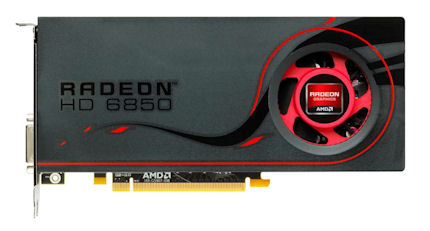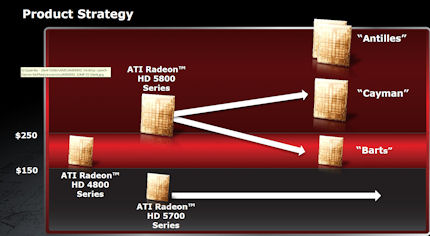Radeon 6000 is here
The state of playAMD launched 11 Radeon 5000-series GPUs through a five-month spell from September 2009 to January 2010. Starting off with the high-end Cypress-based duo of Radeon HD 5870 and HD 5850, AMD provided consumers with compelling reasons to purchase Radeon hardware. Now more than a year after launch and with NVIDIA's competing Fermi GPUs populating practically all pricing segments of the discrete graphics-card market, giving enthusiasts the all-important choice, AMD's cards remain very competitive.
It's to AMD's credit that HEXUS continues to recommend year-old hardware which, in the UK, has barely budged in price - thanks only in part to our deteriorating exchange rate. But now arch-rival NVIDIA's GeForce 400-series (Fermi) cards are becoming compelling in their own right, especially in the wallet-friendly $150-$250 segment, so AMD feels the urge to counter.
Repositioning the graphics-card portfolio can take one of two forms. The simplest recourse is a reduction in price, where retailers are incentivised to drop the price of hardware and thus provide consumers with a greater bang-for-buck. Heck, we'd all buy a Radeon HD 5870 or GeForce GTX 470 if they were priced at an untenable $199.
Understandably, if they can possibly avoid it, GPU manufacturers don't want to go down the price-cutting route; it reduces margin on each piece of silicon sold. The second, more favourable method is to encourage consumers into purchasing GPUs by introducing a new architecture that offers more performance for your dollar - be it frames per second and/or features.
Staving off the nascent threat from NVIDIA in the premium graphics-card space, AMD is taking the second option and bringing the all-new 6000-series of GPUs into play. What's more, it's deliberately killing off its star Radeon HD 5850 and HD 5870 cards. Commercial suicide or clever strategy? Let's find out.
The Radeon 68x0: more of the same...for now.
The real goal for any new iteration of GPU is to provide improvements in two crucial metrics: performance per watt and performance per mm². From a manufacturer's point of view, improve both metrics and you have a new GPU which provides the same, or better, performance with lower thermals (power-draw) and at a lower cost (smaller die). It becomes a win-win situation. This is ostensibly what AMD is trying to achieve with the Radeon 6800-series.
Putting this into context, here's a picture of the current high-end product stack from AMD. Its design strategy with the Radeon 5000 cards left it exposed in the jump between the HD 5770 and HD 5850 GPUs. While not shown, this section is anaemically filled by the inelegant Radeon HD 5830, and the $150-$250 area is one which NVIDIA is keen to exploit with its favourably-received GeForce GTX 460 cards.
Plugging this hole, AMD hopes, are the Radeon HD 6850 and HD 6870 'Barts' cards. These arrive armed with improvements in the two metrics discussed above, soon to be followed by a genuine performance GPU in the form of the Radeon HD 6950 and HD 6970 'Cayman' parts and, a little while later, the dual-GPU Radeon HD 6990, code-named Antilles. Phew!
What's in a name?
AMD has taken the somewhat contentious step of juggling the new GPUs' nomenclature around. The $150-$250 Barts chips shouldn't perform as well as the incumbent Radeon HD 5850 and HD 5870 GPUs - they're priced lower, for starters - yet the new duo are called HD 6850 and HD 6870. Prima facie, we don't agree this semi-arbitrary branding. Perhaps AMD should have opted for Radeon HD 6750 and HD 6770 for the Barts chips? Doing so would have prevented the embarrassing situation where the HD 6850, albeit cheaper, doesn't perform as well as the older, lower-numbered HD 5850 in gaming titles.
AMD will counter with the fact that, historically, most x800-series GPUs have been bracketed in the $150-$250 segment. While there is merit in this line of thinking, we're adamant that not-so-savvy enthusiasts may well be tempted into assuming that a jump in generations indicates across-the-board performance gains.
Keep on reading as we show you what AMD has done to hit a lower price point with the mid-range Radeon HD 6800-series cards.











